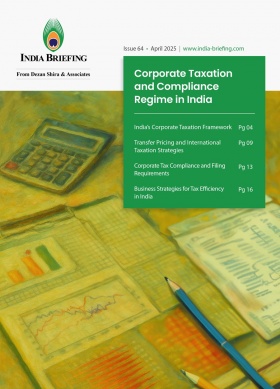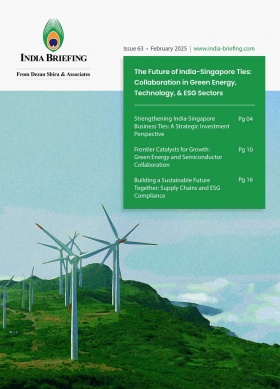India’s FTA Network: Updates in 2025
India’s foreign trade landscape is evolving rapidly, driven by active FTA negotiations and revisions to existing trade treaties with key global markets. As of 2025, India is in talks with major partners, including the US, EU, and ASEAN, while also exploring new agreements with Africa, Latin America, and the Arab Gulf. India Briefing brings you the latest updates on the country’s trade negotiations and economic partnerships.
As of 2025, India has 13 active Free Trade Agreements (FTAs) and several ongoing negotiations aimed at strengthening bilateral and regional trade partnerships. Additionally, India is reevaluating its investment treaties and preferential trade agreements to align with contemporary economic realities, ensuring a balanced approach between global investor protection and national interests.
This tracker provides an overview of India’s trade agreements, including existing pacts and ongoing negotiations.
Classification of India’s trade agreements
- Free Trade Agreements: FTAs are legally binding treaties between two or more countries aimed at reducing or eliminating trade barriers, such as tariffs, quotas, and restrictions on imports and exports. These agreements often include provisions for trade facilitation, intellectual property rights, and investment protections.
- Preferential Trade Agreements (PTAs): Unlike FTAs, PTAs offer selective tariff reductions on specific goods, rather than complete elimination. Some of the examples of such agreement include the India-MERCOSUR PTA and the India-Chile PTA.
- Comprehensive Economic Partnerships/Cooperation Agreements (CEPAs/CECAs): These agreements go beyond FTAs by including provisions on investment, services, and regulatory cooperation. This includes the India-South Korea CEPA and the India-Singapore CECA.
- Bilateral Investment Treaties (BITs): BITs focus on protecting and promoting investments between two countries by ensuring fair treatment and dispute resolution mechanisms. For examples, the India-UAE BIT and the India-Uzbekistan BIT.
- Regional Trade Agreements (RTAs): These involve multiple countries within a specific region aiming for economic integration. Examples include the South Asian Free Trade Area (SAFTA) and the Asia-Pacific Trade Agreement (APTA).
India’s FTA updates in 2025
As of July 2025, India is actively engaged in several bilateral trade treaty and FTA negotiations:
- The UK: The India–UK FTA was officially signed and formalised on July 24, 2025. India’s Prime Minister Narendra Modi’s visit to the UK, where he held bilateral discussions with UK Prime Minister Keir Starmer. The agreement was signed by India’s Commerce and Industry Minister Piyush Goyal and the UK’s Secretary of State for Business and Trade, Jonathan Reynolds. The trade pact finalized on May 6, 2025, is projected to enhance bilateral trade between the two countries by an estimated US$34 billion annually.
- European Union: India’s Trade and Economic Partnership Agreement (TEPA) with the European Free Trade Association (EFTA) will be implemented starting October 1, 2025, as per an announcement by the Union Minister of Commerce and Industry Piyush Goyal. The pact, signed on March 10, 2024, marks a key milestone in India’s trade diplomacy. Under the agreement, EFTA—which comprises Iceland, Liechtenstein, Norway, and Switzerland—has committed to invest US$100 billion in India over a 15-year period. This includes US$50 billion in the first 10 years, followed by an additional US$50 billion in the subsequent five years. The investment is expected to generate around one million direct jobs in India. This is the first time India has secured such a large-scale investment commitment as part of a free trade agreement.
- Switzerland: As per reports published on July 12, 2025, Switzerland has formally ratified the Trade and Economic Partnership Agreement (TEPA) with India, marking the completion of the ratification process by all four member states of the European Free Trade Association (EFTA)—Iceland, Liechtenstein, Norway, and Switzerland. The breakthough comes after nearly 16 years of negotiations and paves the way for the agreement to come into effect by October 2025. The Swiss Ambassador Maya Tissafi, has described the development as a “significant milestone” in strengthening Indo-Swiss relations. On June 10, 2025, India’s Union Minister of Commerce and Industry, Piyush Goyal, concluded his two-day visit to Switzerland . The visit focused on advancing the implementation of the TEPA, signed earlier in 2025 between India and the EFTA.
-
Kyrgyzstan: On June 5, 2025, India’s Union Minister for Finance Nirmala Sitharaman and the Foreign Minister of the Kyrgyz Republic, Zheenbek Kulubaev Moldokanovich, signed the protocol and exchanged the Instrument of Ratification for the Bilateral Investment Treaty (BIT) between India and Kyrgyzstan in New Delhi. Originally signed on June 14, 2019, in Bishkek, the treaty officially enters into force from June 5, 2025. It supersedes the earlier BIT that came into effect on May 12, 2000, ensuring continued legal protection for investments between the two nations.
- The US: India and the US are expected to finalize a trade deal soon, aiming to reduce tariffs and help lower the US trade deficit, according to US Commerce Secretary Howard Lutnick. Speaking at a US-India Strategic Forum in Washington D.C., on June 3, 2025, Lutnick noted that while India maintains protectionist tariffs, both sides have found common ground. He emphasized that early agreements tend to be more favorable and assured the US would be flexible if India reduces its tariffs. On May 20, 2025, Commerce and Industry Minister Piyush Goyal met with Lutnick in Washington, D.C., to accelerate discussions on the initial phase of the proposed India–US bilateral trade agreement. This marks his second visit to Washington for trade talks with the US in 2025, following an earlier round in March. In a statement issued on April 29, 2025, Goyal confirmed that officials from India’s Department of Commerce and the Office of the US Trade Representative met in Washington, D.C., between April 23 and 25, 2025. These discussions carry strategic importance for India, particularly in the context of ongoing global economic uncertainty and US tariff realignments. As the US remains one of India’s top export destinations, securing favorable trade terms is a key priority to ensure sustained economic growth and deepen bilateral commercial ties.
- European Union: India and the EU concluded the 11th round of negotiations on the proposed draft of Free Trade Agreement (FTA) May 18, 2025. As per a Times of India report, both sides have agreed to pursue a two-stage approach to finalise the deal. On May 1, 2025, India and the EU reaffirmed their target to conclude free trade agreement negotiations by the end of 2025. As per the statement released by the Ministry of Commerce and Industry, India’s union minister Piyush Goyal, held a key meeting with EU Commissioner for Trade and Economic Security, Maros Sefcovic, in Brussels on May 1 to discuss the progress on the FTA negotiations. Sefcovic, in a media address in Brussels, said that the EU “deeply” values its partnership with India, and it is committed to taking it to the next level by securing a commercially meaningful agreement, which opens up the markets for both goods and services.
- Chile: On May 8, 2025, India and Chile signed the Terms of Reference (ToR) for a Comprehensive Economic Partnership Agreement (CEPA). As per the announcement, India-Chile CEPA aims to build upon the existing PTA between the two countries and seeks to encompass a broader range of sectors, including digital services, investment promotion and cooperation, MSME, critical minerals etc. thereby enhancing economic integration and cooperation.
- United Kingdom: India and the UK finalised the free trade agreement (FTA) after over three years of negotitations. Under the finalized FTA, announced on May 6, 2025, Indian businesses will enjoy nearly tariff-free access to British markets. Additionally, India will benefit from the UK’s FTA commitments in various service sectors, including IT/ITeS, financial, professional, and educational services. One of the major highlights of the agreement is the Double Contribution Convention. Under this, Indian professionals working temporarily in the UK will benefit from a three-year exemption from social security contributions.
- Chile: On April 1, 2025, India and Chile announced the launch of negotiations for a CEPA to enhance cooperation across trade, science and technology, critical minerals, health, agriculture, climate change, and cultural exchanges. As part of this collaboration, Chile has invited Indian companies to bid for lithium deposits, a strategic move to diversify its foreign investment in the mining sector. Additionally, both nations are strengthening ties in mining and mineral exploration. A roundtable discussion, organized by the International Copper Association India, focused on advancing mineral exploration, sustainable mining practices, and value-added processing. Per the announcement, India and Chile have agreed to explore renewing their Memorandum of Understanding (MoU) on geology and mineral resources to establish a more robust framework for future cooperation, particularly in critical minerals and green technology
- New Zealand: India and New Zealand have officially resumed negotiations for a comprehensive Free Trade Agreement (FTA) after a decade-long pause, aiming to strengthen economic ties and expand trade opportunities. The decision was announced on March 16, 2025, following a meeting between India’s Commerce and Industry Minister, Piyush Goyal, and New Zealand’s Trade Minister Todd McClay, ahead of a bilateral discussion between Prime Minister Narendra Modi and New Zealand Prime Minister Christopher Luxon. With bilateral trade surpassing US$1 billion during April–January 2025, the renewed FTA talks are expected to open new avenues for businesses and consumers, driving mutual growth and prosperity.
- United States: India and U.S. aim to double bilateral trade to US$500 billion by 2030. On February 17, 2025, India’s Union Minister Of Commerce and Industry Piyush Goyal said that the two countries are committed to negotiating a strong trade agreement within the next 6-8 months.
- United Kingdom: FTA negotiations between India and the UK are set to resume in early 2025 as per British Prime Minister Keir Starmer’s update to the UK Parliament on November 21, 2024. As many as 14 rounds of negotiations have taken place between both countries till now. The India-UK FTA negotiations began in January 2022.
- Oman: As of February 2025, India and Oman are actively advancing negotiations on a CEPA. India’s Union Minister of Commerce and Industry visited Muscat in January 27-28, 2025, to discuss the CEPA with Oman’s Minister of Commerce, Industry, and Investment Promotion, Qais bin Mohammed Al Yousef. Formal CEPA negotiations commenced in November 2023, with significant progress made by January 2024.
- Association of Southeast Asian Nations (ASEAN): As of February 2025, India and ASEAN are actively engaged in reviewing the ASEAN-India Trade in Goods Agreement (AITIGA), originally signed in 2009. The fifth Joint Committee meeting is scheduled to take place in February 2025, in Jakarta, Indonesia.
- Qatar: Currently, India and Qatar are actively exploring the possibility of an FTA to enhance bilateral trade and investment. During a two-day visit to New Delhi (February 18-19, 2025), Qatari Emir Sheikh Tamim bin Hamad Al-Thani and Indian Prime Minister Narendra Modi discussed strategies to double trade between the two nations to US$28 billion within the next five years.
Other India trade negotiations to watch in 2025
India-Canada CEPA: Negotiations were re-launched in March 2022 during the fifth Ministerial Dialogue on Trade & Investment. However, as of September 2023, Canada has paused these talks, with both countries agreeing to decide on their resumption mutually.
India-Gulf Cooperation Council (GCC) FTA: India and the GCC signed a Framework Agreement on Economic Cooperation in 2004 to strengthen trade ties. FTA negotiations resumed in November 2022, and by January 2025, the GCC expressed intentions to initiate formal discussions within the year. The GCC member countries are Saudi Arabia, UAE, Qatar, Kuwait, Oman, and Bahrain.
Status of India’s bilateral investment treaties
BITs aim to promote and protect investments between India and its partner countries.
In February 2025, Finance Minister Nirmala Sitharaman announced plans to revamp the current Model BIT to make it more investor-friendly, aiming to attract increased foreign investment.
India is negotiating new BITs with the UK, Saudi Arabia, Qatar, and the EU and renegotiating existing ones to align with contemporary economic realities and policy objectives.
Most of India’s earlier BITs (previously known as BIPA (Bilateral Investment Promotion and Protection Agreement)) were terminated following the adoption of a new Model BIT in 2016. This model emphasizes a balance between investor rights and the host state’s obligations.
Notable BITs currently in force include:
- India-UAE bilateral investment treaty: Signed in Abu Dhabi in February 2024, this treaty came into effect on August 31, 2024. Speaking to The Indian Express, Ajay Seth, Secretary of the Department of Economic Affairs (DEA), said the BIT with the UAE, which provides safeguards for foreign portfolio investors and includes entity-based protection, exemplifies the shift toward more investor-friendly investment norms.
- India-Uzbekistan bilateral investment treaty: Signed in 2024, this treaty aims to enhance investment flows between the two nations.
In addition to these, India has active BITs with several countries, including:
- Bangladesh: Fostering investment cooperation between the neighboring countries.
- Belarus: Aiming to protect and promote mutual investments.
- Kyrgyzstan: Enhancing economic collaboration through investment protection.
- Thailand: Strengthening economic ties and investment flows.
- Trinidad and Tobago: Encouraging bilateral investments and economic cooperation.
Switzerland and Liechtenstein are pushing for a BIT with India after the EFTA-India trade agreement committed to a US$100 billion investment over 15 years. Although BITs were initially not discussed, the push comes after India unilaterally annulled older BITs and Switzerland suspended the Most-Favoured-Nation (MFN) clause in its Double Taxation Avoidance Agreement (DTAA) with India. This decision, following an Indian Supreme Court ruling, has led to higher taxes for Swiss firms like Nestlé.
India, which had favored state rights in its 2016 BIT model, is now working on a revamp to offer better investor protections after concerns from Western trade partners.
India’s FTA network: Existing trade agreements
India has established 13 FTAs with various countries and regional blocs. These agreements aim to strengthen India’s trade relations, promote economic growth, and facilitate market access.
- South Asian Free Trade Area (SAFTA) – implemented in 2006 among SAARC nations to reduce tariffs.
- India-Sri Lanka Free Trade Agreement (ISFTA) – in effect since 2000, promoting bilateral trade.
- India-Nepal Treaty of Trade – provides duty-free access to primary products.
- India-Bhutan Agreement on Trade, Commerce, and Transit – eliminates tariffs on a range of goods.
- India-Thailand Free Trade Agreement – initiated in 2004 under the Early Harvest Scheme.
- India-Singapore CECA – covers trade, services, and investment.
- India-Malaysia CECA – effective from 2011, covering trade, services, and investments.
- India-Japan CEPA – eliminates tariffs on a vast majority of goods since 2011.
- India-South Korea CEPA – reduces tariffs and promotes trade.
- India-ASEAN FTA – established in 2010 for goods, expanded in 2014 for services.
- India-Mauritius CECPA – signed in 2021, India’s first trade agreement with an African nation.
- India-UAE CEPA – implemented in 2022, boosting bilateral trade.
- India-Australia ECTA – signed in December 2022, promoting key sectors like agriculture and minerals.
India’s Generalized System of Preferences (GSP)
Under the GSP, India benefits from preferential tariff treatment under various schemes provided by different countries, facilitating duty-free or reduced tariff access for Indian exports.
|
Provider |
Beneficiaries |
Entry into force |
|
India |
Duty-Free Tariff Preference Scheme for Least Developed Countries (LDCs): 46 countries |
August 13, 2008 |
|
United Kingdom |
Developing Countries Trading Scheme – 65 countries, including India |
June 19, 2023 |
|
Armenia |
Generalized System of Preferences – 153 countries, including India |
October 10, 2016 |
|
Australia |
Generalized System of Preferences – 177 countries, including India |
January 1, 1974 |
|
European Union (EU) |
Generalized System of Preferences – 88 countries, including India |
July 1, 1971 |
|
Japan |
Generalized System of Preferences – 130 countries, including India |
August 1, 1971 |
|
Kazakhstan |
Generalized System of Preferences – 153 countries, including India |
October 10, 2016 |
|
Kyrgyz Republic |
Generalized System of Preferences – 153 countries, including India |
October 10, 2016 |
|
New Zealand |
Generalized System of Preferences – 140 countries, including India |
January 1, 1972 |
|
Norway |
Generalized System of Preferences – 122 countries, including India |
October 1, 1971 |
|
Russian Federation |
Generalized System of Preferences – 153 countries, including India |
October 10, 2016 |
|
Switzerland |
Generalized System of Preferences – 123 countries, including India |
March 1, 1972 |
India’s Preferential Trade Agreements
- SAARC Preferential Trading Agreement (SAPTA) – includes Bangladesh, Bhutan, India, Maldives, Nepal, Pakistan, and Sri Lanka.
- Asia-Pacific Trade Agreement (APTA) – previously known as the Bangkok Agreement, signed in 1975 with Bangladesh, China, India, South Korea, Laos, and Sri Lanka.
- India-MERCOSUR PTA – signed with Brazil, Argentina, Uruguay, and Paraguay in 2004; effective from June 1, 2009.
- India-Afghanistan PTA – signed on March 6, 2003.
- India-Chile PTA – strengthening economic ties with Latin America.
Some proposed regional trade agreements
- Bay of Bengal Initiative for Multi-Sectoral Technical and Economic Cooperation (BIMSTEC) FTA – a proposed FTA agreement involving a grouping of countries in South Asia and Southeast Asia – Bangladesh, Bhutan, India, Myanmar, Nepal, Sri Lanka, and Thailand – aiming to strengthen regional economic integration.
- India-SACU Preferential Trade Agreement – a proposed agreement between India and the Southern African Customs Union (Botswana, Lesotho, Namibia, South Africa, and Eswatini) to improve trade relations.
(This article was originally published on February 20, 2025, and was last updated on July 24, 2025.)
About Us
India Briefing is one of five regional publications under the Asia Briefing brand. It is supported by Dezan Shira & Associates, a pan-Asia, multi-disciplinary professional services firm that assists foreign investors throughout Asia, including through offices in Delhi, Mumbai, and Bengaluru in India. Readers may write to india@dezshira.com for support on doing business in India. For a complimentary subscription to India Briefing’s content products, please click here.
Dezan Shira & Associates also maintains offices or has alliance partners assisting foreign investors in China, Hong Kong SAR, Dubai (UAE), Indonesia, Singapore, Vietnam, Philippines, Malaysia, Thailand, Bangladesh, Italy, Germany, the United States, and Australia.
- Previous Article India’s Updated Income Tax Return Forms for AY 2025–26 Explained
- Next Article India Signs Historic Trade Deal with UK: What It Means for the Two Economies








